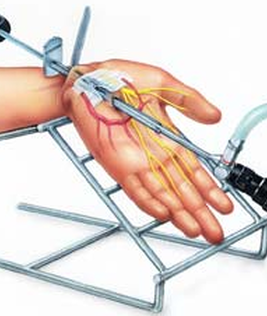What is Carpal tunnel Syndrome ?

Carpal tunnel syndrome occurs when the median nerve of the hand is compressed within the transverse carpal ligament at the wrist.
The median nerve provides sensation to the thumb, the index finger, the middle finger and some parts of the ring finger .
The carpal tunnel is the area in your wrist where the median nerve and many tendons traverse your wrist and go into your hand. It is a narrow and tight tunnel which is why carpal tunnel syndrome can happen so easily – any swelling in this area can pinch the nerve causing pain, numbness, tingling, or weakness.
The nerve is compressed when through the carpal tunnel. This unstreatchable canal is between the ossicles of the wrist on one side and a thick ligament on the other (see diagram). In addition to the median nerve 9 tendons of the fingers borrow the carpal tunnel.
The nerve is compressed either because of the augmentation in volume of the tendons and their corresponding synovial membrane or because of the narrowing of the canal (osteoarthritis-fracture).
How do i know if I have the Carpal Tunnel Syndrome ?
The Carpal Tunnel syndrome is frequent, especially in women older than 50.
Workers using force and strength and performing a repetitive gesture are more often suffering from it than the others.
Finally some diseases are more likely to be associated with the Carpal Tunnel Syndrome : Hyperthyroidism, Rheumatoid arthritis, Amyloidosis, diabetes
What are the symptoms ?
The Carpal tunnel syndrome causes pain, tingling and numbness of the thumb, forefinger, middle finger and sometimes the ring finger.
Pains can spread to the entire hand and arm.
Symptoms usually appear at night. The syndrome can appear at both hands.
In case of severe compression, the patient experiences a progressive loss of the sensitivity of the fingers. It is better to operate before reaching a loss of sensitivity because recovery is not always complete.
What other additional examination that should I have ?
• The radiography of the wrists and hands is not systematically prescribed
• The electromyogram measures the capacity of the median nerve to transmit electrical signals
This examination confirms the diagnosis, locates the level of compression and looks for an abnormality on the other nerves of the arm.
What treatments are available ?
Rest and a splint usually help treat the symptoms.
If the symptoms persist, a corticosteroid injection can temporarily be made.
If treatments fail to cure the patient, a surgery must be performed.
It allows to lower the pressure in the carpal tunnel and decompress the median nerve. The procedure consists in opening the thick ligament which closes the canal (see diagram). The synovium that surrounds the tendons can be removed when it is thickened.
The procedure is performed under local anesthesia made on the arm.
Post-operative :
A reinforced and bulky dressing is made for around 8 to 12 days.
Tingling and finger pain, due to carpal tunnel syndrome, usually disappear on the evening of the surgery.
Patients must move their fingers when the anesthesia has no longer any effect, as self-restoration of the senses and avoid a few physiotherapy sessions.
The first post-operative appointment is on the 8th to 12th day following the surgery. It is done so as to :
- Assess the surgery efficiency
- Remove the stitches from the scar
Duing this post-operative consultation, the surgeon gives you the following instructions :
- Do not carry heavy loads
- Mobilize the fingers in extension and flexion toward the palm of the hand
- Resume to work depending on the manual activities. Hence,
A second post-operative appointment is planned between week 5 and week 8. It aims to :
- Assess finger mobility
- Check the absence of recurrence of carpal tunnel syndrome
- Observe the nerve regrowth (early sensitization of the hand if it has shown signs of decreased sensitivity before the intervention)
It usually takes 3 to 6 months to “forget” about the surgery. At this time, often the scars are almost invisible and you would have gained back the force of tightening of the fingers .
